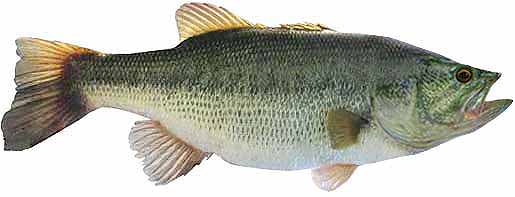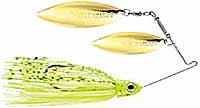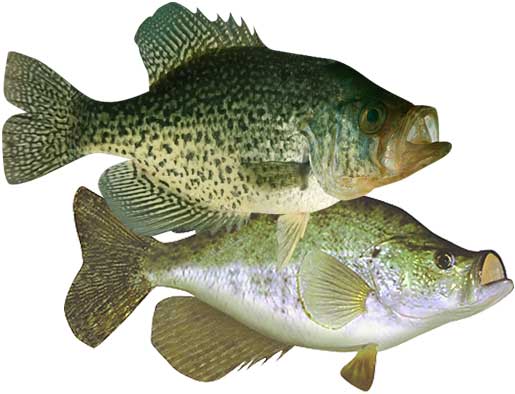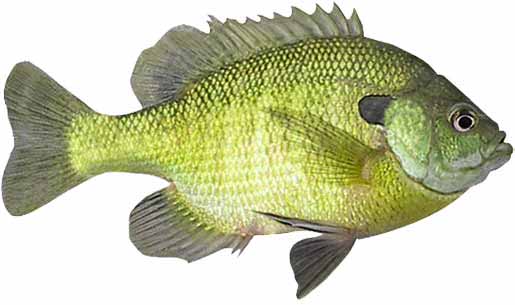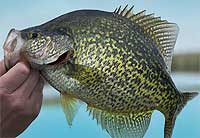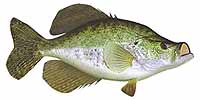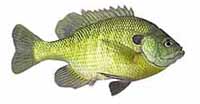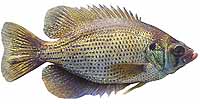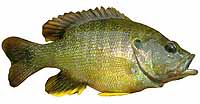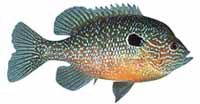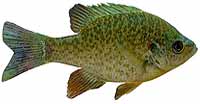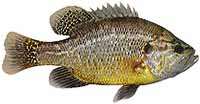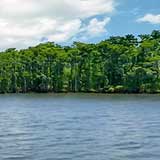Fishing Report For Lake Maurepas, LA
By Rick Seaman
August 5, 2025
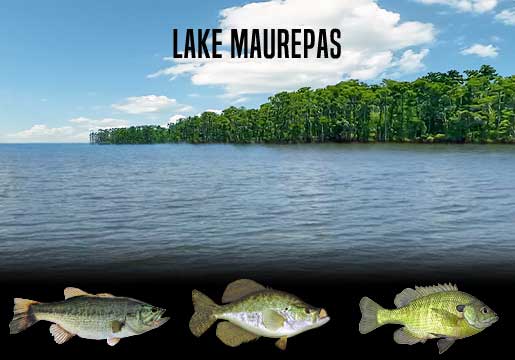
Fishing Reports
Popular Fish Species Lake Maurepas, LA
Largemouth Bass
Current Report:Fair To Good
SUMMER. Water temperatures are in the mid 80's, so summer patterns are in full swing. Bass are feeding shallow early and late in the day, where they are being caught on topwater, squarebill crankbaits and swimbaits. Wacky-rigged stick worms are catching finicky bass when the bite is slow. Largemouth bass here feed on gizzard shad, threadfin shad, small sunfish and crawfish. During the hotter parts of the day, they are being caught channel relatively shallow in weedy or shady areas around the Cypress trees.
FALL. When Fall arrives, bass here will follow schools of baitfish into shallow bays where swimbaits, and slow-rolled spinnerbaits have been successful in prior years. As deeper water cools, bait and bass move out to drops in deeper water, and humps where vibrating jigs are often the ideal bait.
WINTER. Winter will isolate them around slightly deeper structure, flats, points and creek channels. They can be found at all depths, even shallow on warm days. Here they hold, feeding less frequently, awaiting warmer water to return in Spring.
SPRING. Once water temperatures rise into the low 60's, largemouth will move from wintering holes, to shallower water just outside spawning areas. Swimbaits, spinnerbaits and vibrating jigs typically get bites just away from the shoreline. At this time they are preparing for the spawn. Once water warms into the mid to high 60's, they will move into 1 to 4 feet of water, and create nests, then lay their eggs. Immediately afterwards, females move out of the spawn beds and males remain to guard the eggs, and then the fry. After a couple weeks, the males also move to slightly deeper water. Crankbaits, vibrating jigs, plastic worms and swimbaits are catching bass during this period.
Black & White Crappie
Current Report: Good To Very Good
Both black crappie and white crappie reside here with white crappie the more favored species.
SUMMER. Water temperatures are currently in the mid to mid 80's, and crappie fishing has been good. Now that the spawn is over, and the hot Summer sun is warming the shallows, crappie have retreated to deeper water and embedded in the shade of heavy vegetation. Anglers are also locating schools of crappie using electronics and fish finders.
FALL. Baitfish, which will be moving into shallow flats and bays, will draw crappie into these areas, where they will feed heavily in preparation for the cold Winter. Small spoons, along with minnows, hair jigs, and crappie jigs, are good options during this feeding marathon.
WINTER. Once the shallows start cooling rapidly, crappie will migrate to slightly deeper holding areas, mostly off shore. At this time they are typically caught using a very slow presentation, in 10 to 12 feet of water.
SPRING. In early Spring, crappie begin staging in 6 to 8 feet of water, just outside shallow spawning areas. Spring is the ideal time to be on the water, as crappie have moved shallow to spawn. At that time, they are typically caught in 2 to 4 feet of water. Docks, brush, tree trunks, and vegetation are where most anglers are catching good numbers using small crappie jigs or live minnows. After the spawn, crappie move outside the spawning area and typically hold slightly deeper on the closest cover. Once they move off the beds, anglers are reporting good success using fish finders and forward facing sonar to locate schools of crappie, which tend to stack vertically around cover. Light tackle with 4 lb to 8 lb line is a popular choice.
Bluegill
Current Report: Good To Very Good
Bluegill, along with redear sunfish, warmouth and other species of bream are a primary food source for predator fish here. They make a tasty fish fry, and are a favorite of locals.
SUMMER. Following the spawn, most of the bigger bluegill migrate to deeper water, away from shore. They prefer to hang around Cypress tree trunks and vegetation. Small underspins, and mini-crankbaits are catching some of the bigger bluegill. Nightcrawlers are also catching good numbers.
FALL. Cool, Fall weather drops the water temperature in the shallows and lures both baitfish and bluegill to move toward the shoreline. Shallow areas with cover are holding bream at this time of year.
WINTER. Cooling shallows have driven the bluegill back to slightly cover, in water ranging from 10 to 12 feet deep. In areas with no cover, anglers are finding them following schools of baitfish.
SPRING. In early Spring, bluegill migrate from winter holding areas toward the shoreline, and are typically caught around 3 to 6 feet deep. As the water warms to the mid 70's they will begin the spawning ritual, building nests in 1 to 3 feet of water. Many of the bigger bluegill prefer to spawn a bit deeper, depending on water clarity. Small spinners and swimbaits, or jigs tipped with small pieces of nightcrawlers are good choices for catching a lot of bluegill in Spring.
Fishing Video
Fish species to fish for...
Guide to fishing for largemouth bass, spotted bass, channel catfish, blue catfish, black crappie, white crappie, bluegill, flier sunfish, green sunfish, longear sunfish, redear sunfish and warmouth at Lake Maurepas in Louisiana.
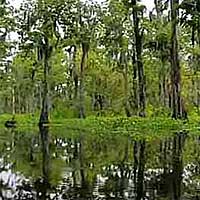
Lake Maurepas is a 58,000-acre lake with over 40 miles of shoreline. It is home to largemouth and spotted bass, black and white crappie, bluegill, catfish, bream, and other sunfish. Sunset Park allows fishing from the bank, other choices for fishing from shore are very limited.
Primary fish species to catch
Click images for fishing tips and details about each species.
Today's Weather & Forecast
Public Boat Launch Ramps & Landings
Click here for boat ramps.
Fishing License
Click here for a Louisiana Fishing License.
Map - Fishing & Access
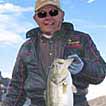
Rick Seaman is a fishing enthusiast with over five decades of fishing experience, a retired tournament fisherman, author of numerous published articles on fishing, and co-author of the book "Bass Fishing - It's not WHAT you throw, It's WHERE you throw it".
Contact Information
Maurepas Swamp Wildlife Mgmt Area
Laplace, LA 70068
985 543-4777
Fishing lakes in each state
080525
Lake Maurepas, Louisiana Report
LOUISIANA


Fishing for crappie, bass, catfish and sunfish in south-central LA.


